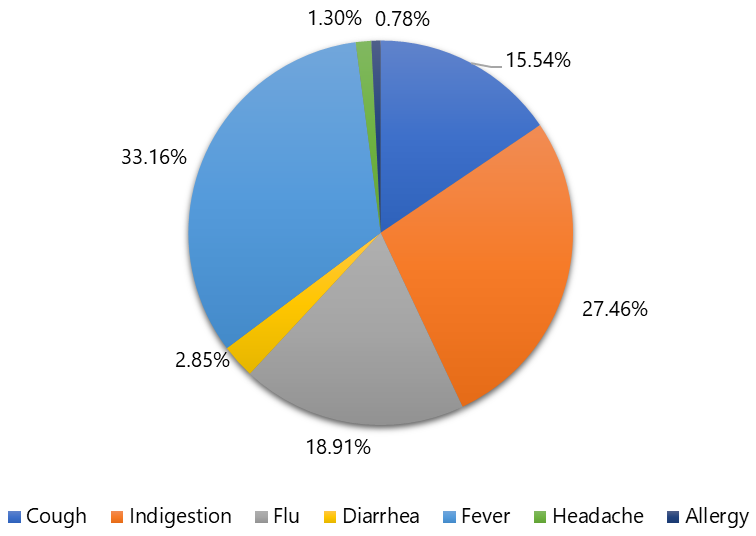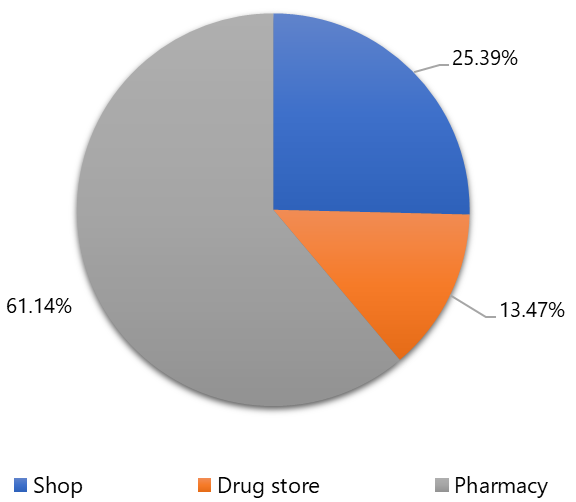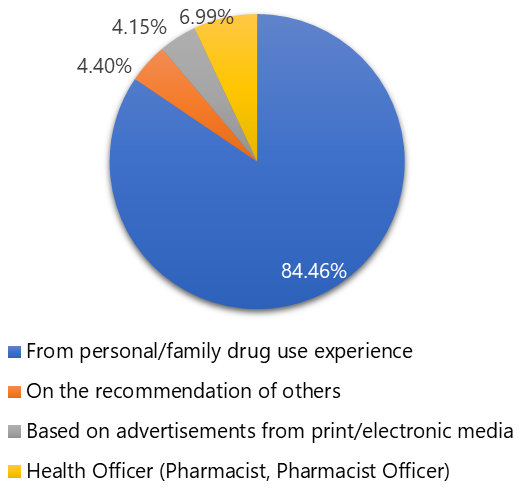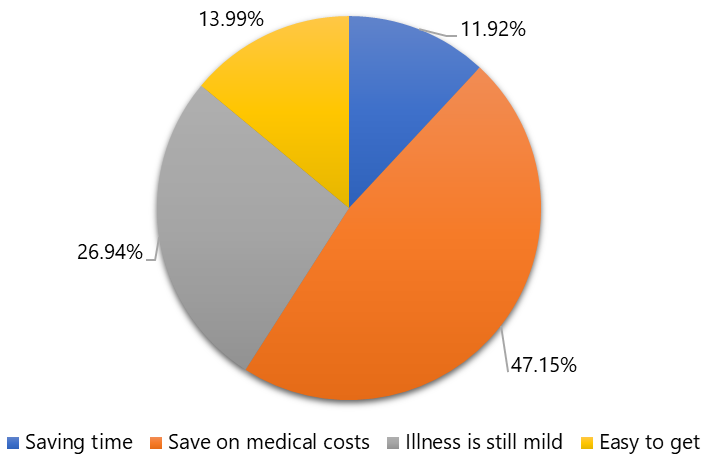Knowledge Level of OTC and OTC Limited Drugs Use for Self-medication in the Community of Tondo Village, Mantikulore District, Central Sulawesi, Indonesia
by Ainun Jariya, Andi Atirah Masyita, Ririen Hardani ★
Academic editor: Mohd Shahezwan Abd Wahab
Sciences of Pharmacy 1(2): 59-64 (2022); https://doi.org/10.58920/sciphar01020025
This article is licensed under the Creative Commons Attribution (CC BY) 4.0 International License.
19 Sep 2022
17 Oct 2022
18 Oct 2022
19 Oct 2022
Abstract: Self-medication, the act of treating oneself without a doctor's prescription, carries inherent risks, as evidenced by the substantial 85.85% engagement in this practice among Central Sulawesi residents in 2021, according to the Indonesia Central Bureau of Statistics. This study, conducted in Tondo Village from August to November 2021 with a sample of 386 respondents, aimed to illuminate the characteristics of those partaking in self-medication. Noteworthy findings included a majority of female respondents (52.3%), aged 26-35 (24.4%), engaged in household work (31.1%), and with a high school education background (46.4%). Common minor illnesses addressed through self-medication encompassed fever (15.54%), ulcers (7.46%), coughs (15.54%), flu (18.91%), diarrhea (2.85%), headaches (1.30%), and allergies (0.78%). Examining over-the-counter (OTC) and OTC limited medicines, prevalent choices included paracetamol for fever (33.16%), antacids for ulcers (75.70%), Komix® for coughs (28.8%), Mixagrib® for flu (36.99%), Entrostop® for diarrhea (70.00%), Ibuprofen for headaches (100%), and CTM for allergies (100%), with 61.46% procured from pharmacies or drug stores. The selection of medications often stemmed from personal or familial usage history (84.46%), and 47.15% opted for self-medication to economize on treatment costs. Encouragingly, the study found that 75.09% of respondents exhibited good knowledge regarding the use of OTC and OTC-limited drugs for self-medication, underscoring the importance of ongoing education and awareness for responsible self-medication practices in the community.
Keywords: Over-the-counter medicine (OTC)Self-medicationDrug use knowledge
Introduction
The community usually does self-medication. This means that if they have to go to a hospital or practice doctor, the patient will be charged for diagnosis and drug costs, thus making the basic reason why many people still carry out self-medication without scientific evidence (1).
The act of self-medication in using over-the-counter (OTC) and OTC-limited medicines is based on several considerations, including being easy to do, easy to get, and not as expensive as going to the hospital. However, they know that the drugs they use only treat the symptoms of the disease. Self-medication can be risky if it is carried out continuously to treat diseases that are not healed. People generally don't realize that OTC drugs and limited OTC drugs that they consume can cause adverse side effects to the body. Some drugs used freely with self-determined doses are not as safe as drugs with a doctor's prescription. Therefore, when a person consumes OTC and OTC-limited drugs that are not following the recommended dosage, it will cause side effects, other adverse reactions, or poisoning (2)
The number of neighborhood units (Rukun Tetangga) in Indonesia that store drugs for self-medication are 103,860 or 35.2%, with the highest percentage being in DKI Jakarta, as much as 56.4%. The lowest occurrences (17.2%) are in East Nusa Tenggara (NTT). On average, there are 3 kinds of drugs stored by the people. It was found that 35.2% of households stored OTC drugs, 35.7% stored prescription drugs, and 27.8% stored antibiotics. The discovery of several prescription drugs and classes of antibiotics for self-medication means that many people still use drugs irrationally. It was found that 81.9% of households in Indonesia used and stored prescription drugs, and 86.1% of households in Indonesia stored antibiotics without a doctor's prescription. Drugs can be grouped into several statuses, namely drugs that are 'currently being used' (32%), drugs that are stored 'for a stock' (47.0%), and the rest from previous drug use 'leftover drugs' (42.2%). Indonesia government has recommended throwing away the residual of previous use drugs because it can lead to misuse (misused) or expiration (3)
Based on data from the Indonesia Central Bureau of Statistics (BPS) regarding self-medication carried out by the Indonesian population, people who self-medication 69.43% in 2017, which continuously increased to 70.74% in 2018, and 71.46% in 2019. According to data from the Indonesia Central Bureau of Statistics (2022), the prevalence of self-medication in Central Sulawesi was 77.97% in 2017, 73.93% in 2018, 75.45% in 2019, 76.2% in 2020, and 85.85% in 2021. Based on observations made in 10 Tondo, Mantikulore, Central Sulawesi pharmacies, almost all people buy drugs without a doctor's prescription. Therefore, this study aimed to determine the knowledge level of the Tondo community in using OTC and OTC-limited drugs for self-medication.
Methodology
This study is descriptive observational research using a questionnaire with a cross-sectional approach that met the inclusion and exclusion criteria. The questionnaire format can be seen in the Supplemental Data.
Time and Place
The research was conducted in the Tondo Village, Mantikulore District, Central Sulawesi. This research was held from August – November 2021.
Sample and Population
The population of this study were all Tondo people who had self-medication and had met the inclusion and exclusion criteria. The inclusion criteria were people who have done self-medication using OTC or OTC-limited medicines, have no mental disorders, are willing to fill out questionnaires, and are between 18 and 65. The exclusion criteria were incomplete questionnaire data.
Results and Discussion
The number of samples collected was 386 respondents with complete questionnaire data (see Table 1). Respondents aged 18-65 with a history of education ‘did not go to school’ to undergraduate. This demonstrates that the sample employed was homogenous, indicating the public's level of understanding of self-medication.
Table 1. Respondents’ characteristics.
|
Parameters |
Number (n = 386) |
Percentage |
|
Age (year) |
||
|
18 – 25 |
84 |
21.8% |
|
26 – 35 |
94 |
24.4% |
|
36 – 45 |
90 |
23.3% |
|
46 – 55 |
77 |
19.9% |
|
56 – 65 |
41 |
10.6% |
|
Gender |
||
|
Female |
202 |
52.3% |
|
Male |
184 |
47.7% |
|
Job |
||
|
Retired |
1 |
0.3% |
|
Government employees |
6 |
1.6% |
|
Entrepreneur |
108 |
28.0% |
|
Private employees |
25 |
6.5% |
|
Housewife |
120 |
31.1% |
|
Student |
53 |
13.7% |
|
Laborer |
10 |
2.6% |
|
Driver |
7 |
1.8% |
|
Farmer |
40 |
10.4% |
|
Honorer |
12 |
3.1% |
|
Security |
1 |
0.3% |
|
Blacksmith |
1 |
0.3% |
|
Bricklayer |
2 |
0.5% |
|
Education |
||
|
Unschooled |
4 |
1.0% |
|
Elementary school |
117 |
30.3% |
|
Junior high school |
69 |
17.9% |
|
Senior high school |
179 |
46.4% |
|
Undergraduate |
17 |
4.4% |
According to Table 1, self-medication responders ranged in age from 26 to 45 years. They were confident in self-medication because of previous experience (4). Pain symptoms become more common with age, and there are risk factors for developing degenerative illnesses in old life (5). Furthermore, individuals in this age group are eager to make the initiatives to heal themselves (6). Figure 1 depicts the fraction of disorders that are frequently treated independently.

Figure 1. Common diseases treated through self-medication.
Based on the results in Figure 1, it can be seen that most people carry out self-medication in dealing with fever, followed by ulcers. According to Barbi et al. (2017), fever is one of the most common signs of illness (7). Taribuka et al. also stated that fever was the reason behind 15-25% of patient visits at healthcare facilities or emergency units (8). Meanwhile, gastritis is a functional disorder usually due to excessive gastric acid and lack of mucus production (1). As said before, responses range from 18 to 65, a productive time typically more stressful due to job. Ulcers can also be induced by other causes, such as irregular eating patterns, the intake of coffee, tea, cola, alcohol, and spicy foods, and stress (9).
According to Table 2, Komix® led the medications used for cough self-medication by as many as 17 persons with a proportion of 28.81%. This is because Komix® is reasonably priced, easy to procure, and simple to use. Komix® includes dextromethorphan as a cough suppressant, which is the most extensively used due to its availability, effectiveness, and safety profile when taken at a prescribed dosage (10).
Table 2. Type of medicines used by Tondo people in self-medication.
|
No |
Medicines |
Number (n = 386) |
Percentage |
|
No |
Medicines |
Number (n = 386) |
Percentage |
|
1. |
Cough |
|
4. |
Diarrhea |
||||
|
|
Komix® |
17 |
28.8% |
|
|
Diatabs® |
1 |
10.0% |
|
|
Vicks® |
11 |
18.6% |
|
|
Entrostop® |
7 |
70.0% |
|
|
Konidin® |
6 |
10.2% |
|
|
Diaform® |
2 |
20.0% |
|
|
Bodrex® |
7 |
11.9% |
|
5. |
Fever |
||
|
|
Siladex® |
11 |
18.6% |
|
|
Paracetamol |
115 |
89.1% |
|
|
Bisolvon® |
3 |
5.1% |
|
|
Sanmol® |
14 |
10.9% |
|
|
Paramex® |
1 |
1.7% |
|
6. |
Headache |
||
|
|
Dextromethorphan |
1 |
1.7% |
|
|
Ibuprofen |
6 |
100.0% |
|
|
Woods® |
2 |
3.4% |
|
7. |
Allergy |
||
|
2. |
Maag |
|
|
CTM |
2 |
100.0% |
||
|
|
Antasida |
81 |
75.7% |
|
|
|
|
|
|
|
Promag® |
15 |
14.0% |
|
|
|
|
|
|
|
Mylanta® |
11 |
10.3% |
|
|
|
|
|
|
3. |
Flu |
|
|
|
|
|
||
|
|
Procold® |
13 |
17.8% |
|
|
|
|
|
|
|
Panadol® |
18 |
24.7% |
|
|
|
|
|
|
|
Mixagrib® |
27 |
37.0% |
|
|
|
|
|
|
|
Demacolin® |
5 |
6.8% |
|
|
|
|
|
|
|
Paramex® |
5 |
6.8% |
|
|
|
|
|
|
|
Decolgen® |
5 |
6.8% |
|
|
|
|
|
Antacids were the most often used for stomach ulcers. According to Ulfa (2016), antacids are drugs that can neutralize the acid in the stomach and are not absorbed into the body, so they are quite safe to use (at recommended dosage) (11). For flu symptoms, self-medication is dominated by Mixagrib®. This is because Mixagrib is relatively cheap and easy to obtain. In addition, Mixagrib® also contains phenylene, a decongestant group with a mechanism of action through vasoconstriction of nasal blood vessels, thereby reducing secretion and swelling of the mucous membranes of the nasal passages and helping to open nasal obstructions (12). For diarrhea, the people of Tondo often use Entrostop®. This is because Entrostop® is relatively safe for consumption by children, pregnant women and breastfeeding mothers. According to Sholekhudin (2014), Entrostop® belongs to the class of adsorbents that work by binding to germs or toxins in the gastrointestinal tract (13). On fever symptoms, it can be seen that the drugs often used for self-medication are dominated by generic paracetamol followed by sanmol. It is known that sanmol is a drug that contains paracetamol as well. Paracetamol is widely used and relatively easy to find in drug stores and pharmacies. This follows research conducted by Aqeel T. et al. (2014), which states that the analgesic drug class is widely used in self-medication, especially paracetamol, by 42.8% (14). Ibuprofen is the drug most often used to relieve headaches. According to Fokunang et al. (2018), Ibuprofen is one of the three most commonly used NSAIDs besides naproxen and aspirin (14). As for allergies, it can be seen that the drug used for self-medication is Chlorpheniramine or commonly abbreviated as CTM. According to Hano et al. (2015), Chlorpheniramine Maleate is an H1 antihistamine drug often used as a first choice to prevent or treat symptoms of allergic reactions (15).

Figure 2. The place to purchase the medicines.
Pharmacies are the most common places to purchase drugs for self-medication. As is well known, pharmacies are pharmaceutical service facilities where pharmacists practice. Tondo has 17 pharmacies, making it easier for consumers to access and purchase medications. A professional pharmacist must oversee the operation of the pharmacy (16). People trust pharmacists more when it comes to medicine purchases, based on the number of people who shop at pharmacies. Another factor might be that pharmacists provide comprehensive medication information (17). Furthermore, respondents feel that pharmaceuticals supplied in pharmacies are higher quality (18).
According to the data presented in Figure 3, the primary reason for self-medication is a personal or family experience with the drug. This follows the research results by Andika, CR & Lestari (2020) regarding information sourced from family and relatives, which is very high compared to treatment information from other sources (19). Respondents believe that the pharmaceuticals used by their family will have the same therapeutic impact on them (18). Furthermore, the effect of the family happens indirectly through the behaviours of other family members in carrying out their treatment, whether from the sort of medicine used or how it is consumed. Other indirect impacts may emerge from the family providing medicine at home, which family members will utilize if someone has a health concern. As a result, one family has the propensity to use the same type/brand of drugs for the same health issues.

Figure 3. Factors affecting drug selection.

Figure 4. Reason for self-medication.
Figure 4 shows that most respondents preferred to self-medicate to save money on medical bills. This occurs because individuals believe that hospital treatment would be provided with additional expense. Furthermore, the use of BPJS must go through a time-consuming process. Furthermore, the respondents' second most common explanation was that the disease was still mild. This occurs because individuals believe that mild ailments do not require medical attention since the self-medication they receive is enough. Self-medication services are projected to be the community's primary service for treating minor ailments. This is consistent with Ilmi T. et al. (2021) viewpoint, which argues that economic difficulties are one of the elements associated with self-medication (5).

Figure 5. Level of knowledge in using OTC and OTC limited.
According to Figure 5, most Tondo residents know about self-medication. This is complemented by detailed indications and usage information on the package, making self-medication easy for the general population. Furthermore, the age level of respondents, which is dominated by adults with a high school or similar education background, might make it simpler for individuals to comprehend and apply information, whether it is gained from other people, electronic media, or health education. According to Notoatmodjo (2012) in his book Health Promotion and Health Behavior, education influences the learning process; the better a person's education, the simpler it is to acquire knowledge (20). According to Ukkas (2017), the productive age range is 15-50 years (21). People of this generation can swiftly adapt to, comprehend, and apply technology, and their horizons are wider than those of non-productive ages.
Furthermore, the questionnaire answers suggest that most respondents are well-versed in classifying drugs, their usage, and how to utilize them. Respondents can recognize the symbol or label on drug packaging for OTC and OTC limited medicines. OTC pharmaceuticals have a green circle with a black border, whereas OTC limited drugs have a blue circle with a black border (22). Furthermore, responders can grasp the drug's advised use in the container (23).
Conclusion
Tondo residents who self-medicate are between the ages of 26 - 35, mostly female (53.3%), a housewife (31.1%), and have completed high school (46.4%). Fever (33.16%), ulcer (27.46%), cough (15.54%), flu (18.91%), diarrhea (2.85%), headache (1.30%), and allergies were the most often self-medicated diseases or symptoms. OTC and OTC limited drugs used for self-medication include paracetamol (33.16%), antacids (75.70%), Komix® for cough (28.8%), Mixagrib® for flu (36.99%), Entrostop® for diarrhea (70.00%), Ibuprofen (100%), and CTM for allergies (100%). People believe more and prefer to get medications from pharmacies. In addition to saving money on medical bills, the most common reasons for self-medication include personal experience and a family history of usage.
Declarations
Ethics Statement
Not applicable.
Data Availability
The unpublished data is available upon request to the corresponding author.
Funding Information
Not applicable.
Conflict of Interest
The authors declare no conflicting interest.
References
- Dewi, S, V., & Malita I. Rancangan Sistem Pakar Mendiagnosa Penyakit Lambung Menggunakan Metode Forward Chaining. J Informatics Comput Sci. 2019;5(1).
- Hidayati, A., Haafizah, D., Murtyk, D P. Tingkat Pengetahuan Obat Bebas dan Obat Bebas Terbatas untuk Swamedikasi Pada Masyarakat RW 8 Morobangun Jogotirto Berbah Sleman Yogyakarta. J Ilm Manuntung. 2017;3(2):139–49.
- Indonesia DKR. Farmakope Edisi III. Indonesia DKR, editor. 1979.
- Zulkarni, R., Tobat, S.R., Aulia S. Perilaku Masyarakat dalam Swamedikasi Obat Tradisional dan Modern di Kelurahan Sapiran Kecamatan Aur Birugo Tigo Baleh Kota Bukittinggi. J Kesehat. 2019;10:1–5.
- Ilmi, T., Suprihatin, Y., Probosiwi N. Hubungan Karakteristik Pasien dengan Perilaku Swamedikasi pada Masyarakat di Apotek Kabupaten Kediri, Indonesia. J Kedokt dan Kesehat. 2021;17(1):21–34.
- Supadmi W. Gambaran Pasien Geriatri Melakukan Swamedikasi di Kabupaten Sleman. Pharmaciana. 2013;3(2):45–50.
- Barbi, E., Marzuillo, P., Neri, E., Naviglio, S., Krauss B. Fever in Children : Pearls and Pitfalls. Children. 2017;4(81):1–19.
- Taribuka, N., Siti, R., Irma S. Gambaran Pengetahuan dan Penatalaksanaan Ibu Dalam Menangani Hipertermi pada Balita di Wilayah Kerja Puskesmas Perawatan Haria Kecamatan Saparua Kabupaten Maluku Tengah. Glob Heal Sci. 2020;5(3).
- Dipiro, JT., Wells, BG., Schwinghammer T. Pharmacotherapy : A Pathopsyological Approach 9th Edition. New York: Mc Graw Hill Company Inc; 2016.
- Martinak B. Dextromethorphan in Cough Syrup : The Poor Man’s Pyschosis. Psycopharmacology Bull. 2017;47(4):59–63.
- Ulfa AM. Analisa Kadar Tablet Antasida Di Beberapa Apotek Kota Bandar Lampung Secara Alkalimetri. J Kebidanan. 2016;2(1):1–6.
- Gitawati R. Bahan Aktif Dalam Kombinasi Obat Flu Dan Batuk-Pilek, Dan Pemilihan Obat Flu Yang Rasional. Media Penelit dan Pengemb Kesehat. 2014;24(1):10–8.
- Sholekhudin M. Buku Obat Sehari-hari. Jakarta: PT Alex Media Komputindo; 2014.
- Aqeel, T., Shabbir, S., Basharat, H., Bukhori, M., Mobin, S., Shahid, H., Waqar S. Prevalence Of Self-Medication Among Urban and Rural Population of Islambad, Pakistan. Trop J Pharm. 2014;13:627–33.
- Hano LN, Yamlean P, Suprianti HS. Formulasi Tablet Klorfeniramin Maleat Dengan Bahan Pengikat Getah Kulit Buah Pisang Goroho (Musa Acuminafe L) Menggunakan Metode Granulasi Basah. Pharmacon. 2015;4(3):29–33.
- Supardi S, Yuniar Y, Sari ID. Pelaksanaan Standar Pelayanan Kefarmasian di Apotek di Beberapa Kota Indonesia. J Penelit dan Pengemb Pelayanan Kesehat. 2020;3(3):152–9.
- Sarwan. Gambaran Pengetahuan Masyarakat Dalam Mengobati Rasa Sakit (Analgetik) Pada Pengobatan Sendiri di Kelurahan Cipedak Jagakarsa Jakarta Selatan. J Farm Bhumi Husada. 2019;6(1):8–14.
- Ritonga K. Pengetahuan dan Rasionalitas Pasien Terhadap Pengobatan Sendiri di Apotek Kecamatan Medan Johor. Medan: Universitas Sumatera Utara; 2019.
- Andika, C, R., & Lestari F. Pola Swamedikasi Obat Diare Pada Mahasiswa Universitas Islam Bandung. Pros Farm. 2020;35.
- Notoatmodjo S. Promosi Kesehatan dan Perilaku Kesehatan. Jakarta: Kementrian Kesehatan Republik Indonesia; 2012.
- Ukkas I. Faktor-Faktor Yang Mempengaruhi Produktivitas Tenaga Kerja Industri Kecil Kota Palopo. Kelola J Islam Educ Manag. 2017;2(2).
- Rahayuda LG. Identifikasi Jenis Obat Berdasarkan Gambar Logo Pada Kemasan Menggunakan Metode Naive Bayes. J Sisfo. 2016;6(1):17–36.
- Nurmala, S., Ambarwati, R., Oktaviani E. Peningkatan Keingintahuan Masyarakat Mengenai Penggunaan Obat yang Baik dan Benar. J Apl Ipteks untuk Masy. 2019;11(30:130–6.

 ETFLIN
Notification
ETFLIN
Notification






